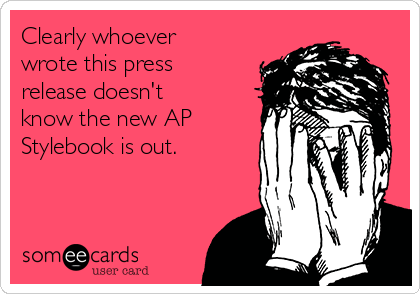Chapter 1: Cornerstones of Communication
Associated Press Style
The majority of journalists and public relations practitioners use AP Style, based on the Associated Press Stylebook. As the foundation for journalistic writing, this style focuses on achieving the best possible accuracy and consistency to make content easily read and understood by readers. This translates to the public relations arena because:
- Adhering to a consistent style improves readability and brand recognition.
- Using AP style gives you a common language with journalists, who often become the mouthpiece for your messages.
Many public relations agencies and corporations interviewing potential employees will require an AP style writing or copyediting test to ensure new hires come in able to write in this style from day one.
Know the Basics
It’s worth your time to learn the basics of AP style that will surface again and again in your writing.
- Dates
- Numerals
- Dollars & percents
- Times
- Addresses
- Titles
- Names
- Composition titles
- Abbreviations
- Social media use
There are a few guiding AP style rules to memorize, but keep a hard copy or online version of the book handy for reference when other questions emerge. Like the English language, there are exceptions to many of the rules, but a few of the often-used AP style standards include:
Every word has one and only one spelling.
- Check the stylebook first – then a dictionary. AP style occasionally has “preferred” spellings. (e.g., adviser rather than advisor)
Avoid unnecessary capitalization.
- Far fewer words should be capitalized than you think.
- Always look it up before you capitalize anything other than proper names.
Avoid excessive abbreviation.
- Including an abbreviation in parentheses immediately after a name usually is not necessary.
- In most cases, capitals and periods are not necessary for an abbreviation.
- Some abbreviations are appropriate on all references: FBI for Federal Bureau of Investigation.
Punctuate according to generally accepted rules.
- Major exception: Items in a series. AP style says not to use the
“Oxford comma” (e.g., The flag is red, white and blue). - The book is a great reference tool. When in doubt, LOOK IT UP.
In general, spell out zero through nine.
- Many exceptions and contingencies to this rule.
- Look up “numerals” entry in the stylebook.
- Pay attention and memorize.
An updated version of the stylebook is published annually. Some years, the changes are minimal and other years they are more significant. Many times organizations will use AP style as their overarching style but customize specifics such as how to abbreviate the organization’s name or whether to capitalize the names of its boards or committees.
Inclusive Storytelling
The 2022-24 edition of the AP Stylebook added a new chapter on “inclusive storytelling.” This chapter offer guidance on ensuring accuracy and fairness by:
- giving voice and visibility to those who have been missing/misrepresented
- showing sensitivity about certain words/phrases
- expanding beyond usual sources and story ideas
- including necessary context and background
- striving to recognize and overcome unconscious biases
- using thoughtful and precise language
The chapter expands pronoun guidance (i.e., use of they/them/their) and includes 35 new or revised disabilities-related entries.
Strong writers make accuracy a top priority. Accuracy goes beyond writing in a way that is grammatically correct. It also means choosing words and putting them together in a way that tells the most accurate version of a story.
The words – even a single word – that we choose to describe a person or convey a scene shape the thoughts and perceptions of readers and listeners…Is the person an addict, or a person with a drug dependency? Is the woman elderly, or a 70-year-old marathon runner?

